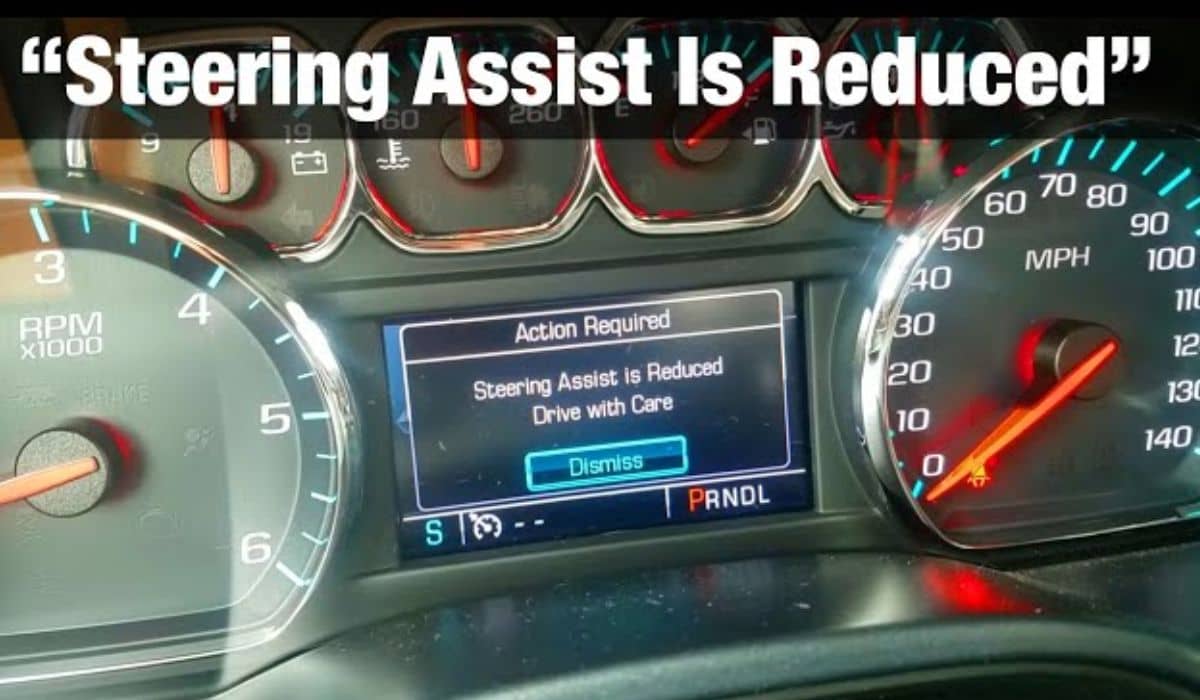Steering assist functionality in vehicles helps drivers by providing additional steering support and stability. However, there may be situations where the steering assist becomes reduced and a warning message is displayed to the driver.
This article provides an overview on when steering assist is reduced drive with care is the only option for you, reasons it can be reduced, and tips for safely driving when this occurs.
What is Steering Assist?
Steering assist refers to features built into a vehicle that help make steering easier and more stable. Here are some common types of steering assist functions:
- Electric Power Steering uses an electric motor to reduce the driver’s effort needed to turn the steering wheel. This helps steering feel lighter and easier compared to manual steering alone.
- Active Steering Assist provides steering input to keep the car centered in the lane. It helps reduce driver fatigue on long drives and keeps the vehicle stable.
- Emergency Steering Assist activates when there is a potential collision risk detected. It prepares the steering system to respond faster if the driver quickly steers to avoid an obstacle.
- These assist functions incorporate advanced sensors, software, and mechanical components to analyze driving conditions and determine when to provide extra steering support. It creates a smoother, safer driving experience.
Why Might Steering Assist Be Reduced?
There are a few potential reasons why a vehicle might display a warning that steering assist has been reduced:
System Faults:
If there is an electrical, mechanical or sensor fault in the steering assist system, it may disable or reduce function to avoid unpredictable vehicle behavior. Warning lights indicate to the driver that full steering support is unavailable.
Extreme Steering Maneuvers:
Aggressive or repeated sharp steering inputs can temporarily disable steering assist. This prevents damage to steering components during extreme maneuvers. Assist function restores after vehicle motion stabilizes.
Environmental Conditions:
Severe weather, low visibility, steep slopes or rough terrain can interfere with steering sensors. This causes assist functionality to scale back to ensure reliability. Warnings remind drivers reduced assistance is available temporarily.
Low System Power:
Loss of electric power steering capability could happen with a dead battery or electrical issues. The high effort needed to turn the wheels alerts drivers that only manual steering is available until underlying issues are addressed.
In most situations, steering assist reduction is temporary to protect vehicle systems or prevent unpredictable behavior. Warning messages indicate assist functioning is limited rather than completely gone.
Driving With Reduced Steering Assist
When a vehicle warns that steering assist has been reduced, it changes the driving experience. Drivers should take care to operate the vehicle safely by following these recommendations:
Pay Attention to Warning Lights
Monitor the instrument cluster for warning lights indicating reduced assist or steering faults. Take warnings seriously and adjust driving accordingly.
Pull over if possible and restart the vehicle to see if the assist function restores. If warnings persist, have the vehicle serviced promptly.
Proceed With Caution
Slow your driving speed and increase following distance behind other vehicles for extra reaction time.
Avoid sharp turns or sudden steering maneuvers that could overwork manual steering capability.
Turn the steering wheel smoothly with constant velocity rather than abruptly “jerking” the wheel rapidly.
Be prepared for increased effort, looseness or unevenness in steering wheel feel until assist function is restored.
Avoid Risky Conditions
Steering issues can be more difficult to control on curves, hills or during heavy braking. Use extra caution in these situations.
Delay discretionary driving in environmental conditions like heavy rain, snow or ice. Loss of assist further reduces traction and control.
Pull over if possible until conditions improve rather than struggling with limited steering capability.
Consider Temporary Alternative Transportation
If warnings persist, consider alternate transportation options. Loss of power steering makes vehicles much harder to control, especially for drivers with limited arm strength or joint issues.
By understanding the purpose of steering assist systems, causes for reduced functionality, and smart precautions while driving, motorists can safely navigate if warning lights indicate diminished steering support.
While inconvenient, these warnings are designed to prevent accidents and damage by altering drivers to problems. Exercising caution until full assist capacity is restored is crucial.
Causes of Specific Steering Assist Reductions
There are a variety of advanced steering assistance technologies in modern vehicles. The type of assisted functionality reduced determines the impacts on drivability.
Electric Power Steering Failure
Electric power steering uses an electric motor to provide additional rotational power when turning the wheel. Problems with power supply, connections or sensors can completely disable assist and revert to manual steering.
Driving becomes much more difficult and unsafe without power steering, especially at low speeds or while stationary. Any steering issues should be addressed urgently if power assist is lost.
Lane Keeping Assist Disabled
Lane keeping assists use a camera to detect road markings and automatically make small steering adjustments to center the vehicle in the lane. This feature disengages temporarily if cameras are obstructed by rain, snow, direct sunlight or windshield obstructions.
It also disables during highly curved roads or intense vehicle maneuvers exceeding system capabilities. Loss of lane keeping limits convenience but does not impact fundamental steering control.
Drivers simply need to steer manually rather than relying on automatic corrections.
Emergency Steering Function Reduction
Emergency systems prepare for urgent evasive actions by priming steering responsiveness when risks are detected. Disabling prevents unpredictable reactions but also slows emergency reaction time.
Without emergency prep, sudden collision avoidance steering relies solely on driver strength and capability. While safer when limitations are present, drivers lose emergency response enhancement and need cautious defensive driving.
The specific type of reduced assist changes impacts and alternatives. Overall, steering capability shifts from augmented smoothness, stability and emergency readiness to manual control.
Understanding the technologies involved and following warning guidance provides the best ability to navigate safely.
Outlook for Steering Assist Reliability Improvements
While today’s steering assistance functions mark a substantial improvement over fully manual systems, limitations still occasionally surface.
As advanced steering designs mature further, dependability, safety and fault tolerance provides a smooth reliable experience motorists can trust implicitly.
Advancing quality control standards for steering components better prevents mechanical defects before installation. Manufacturers focus intently on part longevity and precision performance tolerances during development.
Redundant sensors with self-diagnostic capabilities supply backup data or deactivate appropriately when readings seem implausible. Cross Checking sensor data validates system status.
Enhanced fault response adventuresomely disables assist functionality at the first sign of anomalies. This converts to manual steering proactively rather than struggling to maintain diminished assistance.
Integration of steering sensors with other on-board driver assistance systems allows holistic understanding of vehicle capabilities and limitations for smarter reactions.
Improved extreme condition testing puts steering hardware through rigorous evaluation in hot, cold, wet and bumpy conditions far beyond what typical drivers encounter. This builds confidence for maintaining steering support in most scenarios.
Constant improvement to the reliability and intelligence of steering assistance prevents situations where limited function leaves drivers overly reliant on their own reaction times and strength alone.
While today’s systems are reasonably dependable, they remain an intermediary step until truly dependable self-driving cars.
Until then, smart driver understanding steps in when prompted that steering support faces limitations requiring added attention despite rare occurrence. Staying alert to warnings provides the insight needed to navigate safely regardless of driving conditions.
Conclusion
Steering assist encompasses an array of features designed to enhance a driver’s capability to navigate smoothly and confidently. However, situations that overextend system capabilities, detect faults, or face unpredictable conditions may result in reduced functionality.
Warning lights specifically indicate these temporary decreases in support. Drivers should respond by proceeding cautiously, avoiding risky scenarios, and addressing faults promptly.
While inconvenient, limited steering assist aims to prevent accidents by encouraging conservative operation.
FAQs
What Are Some Types Of Steering Assist Functions?
Electric Power Steering, Active Steering Assist, and Emergency Steering Assist help make steering easier, keep the vehicle stabilized, and prepare the steering system to avoid collisions.
Why Would Steering Assist Become Reduced?
Faulty components, extreme driving maneuvers, bad weather, steep terrain, low system power, and other issues can interfere with assist systems and cause them to scale back functionality as a precaution.
What Should You Avoid While Steering Assist Is Reduced?
Avoid sharp turns, sudden steering, risky driving conditions like heavy rain or icy roads, and routes with hills and curves until the system is restored. Consider alternate transportation if issues persist.
What Happens When Electric Steering Power Is Lost?
Losing power steering assist disables the electric motor making steering significantly heavier and more difficult. This makes driving unsafe in many situations especially at low speeds.
How Might Steering Assist Systems Improve In The Future?
Through redundant sensors, fault-tolerant responses, extreme testing, integration with other vehicle systems, and more stringent quality standards as the technology continues advancing over time.
As vehicle technology continues advancing, steering support dependability also matures to deliver seamless reliable hands-free functioning.
But until autonomous cars take over fully, smart informed drivers play a crucial role keeping roads safe when warnings indicate the vehicle needs a collaborative partnership to steer dependably.
Stay vigilant and responsive to notifications suggesting diminished assistance for confident motoring.





